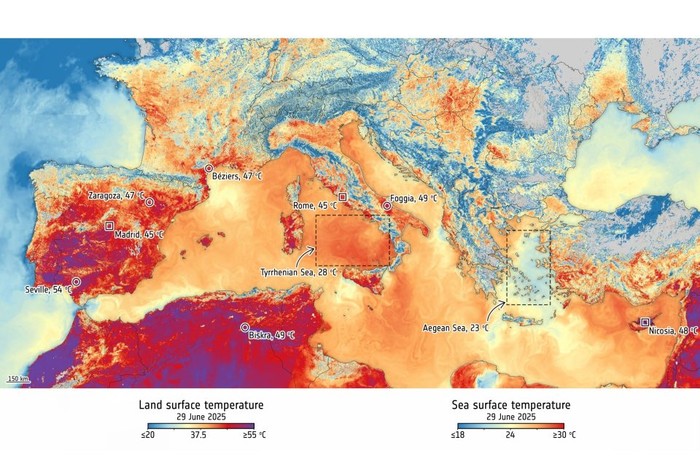Heat Dome Triggers Extreme Heatwaves Across Europe and the US

Extreme heatwaves are not only affecting the United States but are also being felt across various European countries. According to areport from the European Space Agency(ESA), satellite images from Sentinel-3 reveal a significant increase in land surface temperatures across parts of Southern Europe and North Africa. Countries such as Spain, France, Italy, Greece, Cyprus, and Algeria have recorded unusually high land surface temperatures.
The data collected by the satellite measures land surface temperatures, not air temperatures. Surface temperatures are typically higher than the air temperatures recorded by weather stations. This observation is important for assessing wildfire risks, irrigation needs, and urban climate planning.
The main cause of this heatwave is a phenomenon known as a heat dome. In Western Europe, a high-pressure system has remained stationary for an extended period, trapping hot air in the region. This condition is further worsened by hot winds blowing in from North Africa, causing temperatures to rise even more. A similar situation has also been reported in the United States, which has been experiencing severe heatwaves since June 20, 2025. Several areas in the country have broken daily temperature records, with some cities reaching temperatures exceeding 40 degrees Celsius.
This situation has caused various problems, both in terms of public health and infrastructure. High nighttime temperatures have made it difficult for people to sleep, increasing health risks, especially among vulnerable groups. Infrastructure such as roads and railway tracks has also been affected. In some locations, rail tracks have bent due to the extreme heat, even causing delays in train services. In the U.S., local governments have urged residents to conserve electricity and have opened public cooling centers to provide relief.
Experts warn that heat domes will become more frequentdue to climate change caused by human activities. Global warmiing driven by greenhouse gas emissions,has led to shifts in extreme weather patterns. Heatwaves that were once considered rare now have the potential to occur more frequently in the coming decades.
In the long term, the increasing frequency and intensity of heatwaves could have serious impacts on health, agriculture, energy systems, and infrastructure. As a result, various adaptation measures are necessary, such as designing heat-resilient cities, providing public cooling facilities, and improving energy infrastructure to handle high electricity demand.
This phenomenon serves as a starkreminder that the effects of cliimate change are becoming more evident worldwide. Governments and communities are urged to remain vigilant and take concrete action to address this growing threat.







